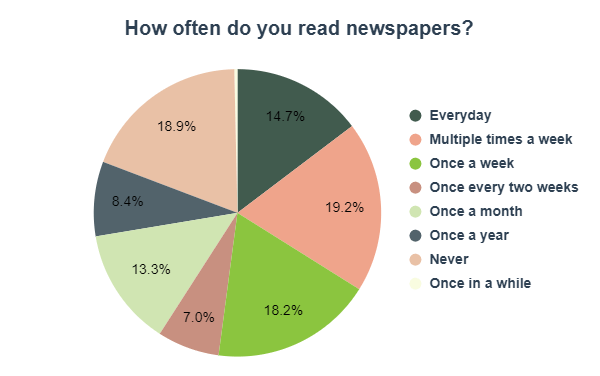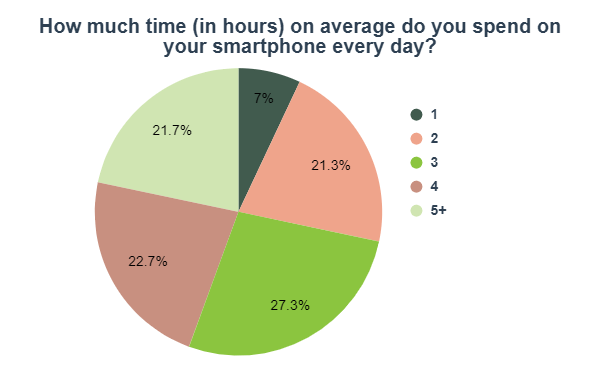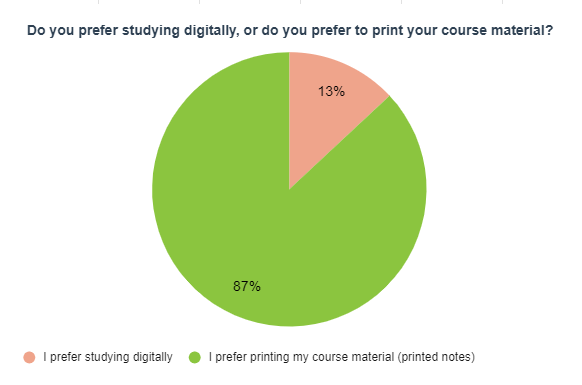
Introduction
In today's digital world, it's vital for advertisers to understand how students use media. Our latest study looks into students' changing media habits, especially their constant use of smartphones and declining usage of traditional media.
Our study aimed to address key aspects of students’ media consumption habits, such as smartphone usage, social media preferences, traditional media engagement, advertising effectiveness, study habits, and preferences for free services with ads.
A Farewell to Tradition: Declining Engagement with Traditional Media
According to our study, smartphones have become central to students' digital lives. 93% of them spend two or more hours daily on handheld devices, with nearly half dedicating 2 to 3 hours to their mobile phones every day. An additional 80% of students engage mostly in social media through their mobile devices. Instagram, Whatsapp, and YouTube topped the list of preferred platforms, with 66%, 54% and 43% of respondents primarily using these platforms.
Traditional media experienced lower engagement, with a considerable portion of students (69%) stating that they do not engage daily with media like TV, radio, general magazines, newspapers, and student magazines. Television and radio usage show a declining trend, with half of the respondents indicating no daily TV consumption and a majority of 66% abstaining from daily radio listening. General magazines exhibited a low usage, with 80% reporting no daily usage. Additionally, student magazines were the least consumed, with 82% of students reporting that they do not consume this type of media.
Furthermore, when asked about engagement in media such as newspaper, 57.9% of respondents stated that they preferred to access digital newspapers over printed.
These findings underline the digital world’s effectiveness in capturing students' attention.

Note: Newspaper engagement by students

Note: Students’ daily smartphone usage
Interestingly, one such medium that remained unaffected by this change was study materials. While digital media dominates daily attention, students still prioritize study material, dedicating a substantial amount of time to academic activities. When asked about their studying habits, 87% of students reported studying for 2 hours or more per day, with almost half of these claiming to spend 2 to 3 hours daily on their course material. However, during exam periods, students tend to dedicate significantly longer hours, with 65.4% of students claiming to spend 7 or more hours daily on their studies.
What’s more fascinating is the type of study material students’ prefer. When asked about their studying preferences, 87% of all respondents expressed a preference for studying with printed materials over digital alternatives. Consequently, a significant 46% of students reported to printing course materials at least once to multiple times a week. In an era seemingly dominated by digitalization, students still have an affinity for printed course materials.

Note: Students’ studying preferences
To Ad or not to Ad ? : Advertisement Effectiveness
In order to discover students’ advertising preferences, students were introduced to a variety of platform alternatives for advertising. These included TV, social media on smartphones, social media on laptop/PC, music apps, video games on both laptop/PC and phones, other apps on laptop/PC and smartphones, newspapers, general magazines, student magazines, and study material.
Our results strongly supported the power of ad-supported models, students stated the following preferences:
- Social media presented high preference of free services with ads, with approximately 95% of students stating they would rather receive ads than pay for social media services.
- Magazines and newspapers received close scores, with 91% and 89% of students preferring to receive free services with ads included, respectively.
- Study materials were favored by 81% of students who preferred free services with the inclusion of ads. TV was also a popular choice, preferred by 77% of students.
- The lowest scores belonged to Music and Streaming apps, with 60% and 68% of students preferring to incorporate ads in these platforms.
Additionally, when asked about how likely they were to remember ads shown on these different platforms, students reported a higher likelihood of remembering ads on television, social media on smartphones and study material compared to other platforms. Particularly, ads on television and social media on smartphones presented the highest chance of retention with approximately 11% and 10% of students respectively, while study materials followed with the third highest retention rate of 7% of students.
Implications
This research provides insights into students' media consumption patterns, highlighting their navigation between digital and traditional platforms. It emphasizes the prominence of smartphones and social media, yet also highlights the significance of traditional media, particularly printed study materials.
Smartphones stood out as the highest used medium with 93% dedicating two or more hours daily to these devices. Additionally, social media was highlighted as the main use for mobile phones. Advertisements on social media platforms also exhibited the highest retention rates. In the context of a choice between paid subscriptions and free services with ads, social media emerges as a clear preference among students, with 95% of students express a preference for receiving ads on social media rather than paying for social media services.
Interestingly, for students, the most significant contender to social media appeared to be their study materials. Despite the growing trend of social media, half of the students still dedicate, on average, 2 to 3 hours daily to their study material, with this commitment intensifying during exam periods, with 65.4% of students spending over 7 hours daily on their study materials. Additionally, a significant majority (86.7) of students expressed their preference for studying with printed materials over digital alternatives. In contrast, when asked about mediums such as newspapers less than half of respondents stated that they preferred to access printed newspapers. Finally, study materials were favored by 81% of students who preferred free services with the inclusion of ads. This preference indicates a willingness among students to tolerate ads in exchange for free access to essential academic content.
In a world dominated by smartphones and social media, we cannot overlook traditional media's enduring impact, especially in the realm of printed study materials. Successful advertising strategies must acknowledge both digital trends and the relevance of printed resources in students' lives.

